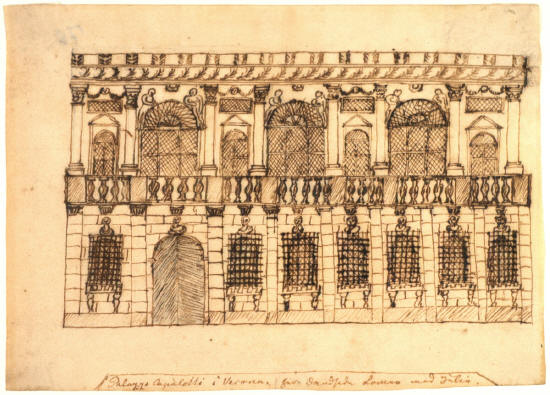Andersen wrote on this drawing, “Palazzo Capuletti in Verona. Here Romeo danced with ,uliet.” According to the diary the drawing was made on April 24, 1834. Kilde: Odense Bys Museer
Sculpture and architecture
Andersen’s most personal drawings from his first major journey include his landscapes with spruce-trees, larches, rocks and waterfalls from Le Locle in the Jura, near the French frontier in Switzerland. They are purely graphic in conception, and can have a sensitive lineal rhythm very reminiscent of a modern artist like Klee. But Andersen’s principal illustrative achievement, perhaps, consists in the many vivid sketches of I talian landscapes and townscapes. Several of these testify to his intimate study of sculpture and architecture he wanted to fix.
There is a surprising expressiveness in his distinct and very subtly differentiated drawing of the sculptured facade of the Palazzo Capuletti in Verona of April 24, 1834 (‘where Romeo fell in love with Juliet’, the diary says). A few days before, he had also drawn Canova’s monument in the Frari Church in Venice.
There is exuberance in Andersen’s drawing, and yet it is not so exuberant as the nature descriptions in his writing, where he reveals himself as a brilliant colourist. In his pen drawings from the south one can find a joie de vivre that is akin to genre pictures of Italian folk life from the Romantic period. He associated with numerous artists in Rome, and not only Danish, headed by Thorvaldsen. He was intensely interested in the Italian Pinelli’s drawings of street life.
Our time, familiar with the styles of modern art, is better qualified than his contemporaries to appreciate his originality both as a silhouettist and as agraphic artist. He worked quite freely, without any particular schooling. He got far in experiencing landscape plastically and, as it were, poetically breathing. Regardless of whatever wrong proportioning or exaggerated emphasizing of details one might point out in his architectural rendering by academic criteria, there is always a fine organic cohesion in the rhythm of his drawings, and not infrequently a striking graphic nerve which can recall van Gogh. Andersen’s pen, in this youthful period when he revelled in absorbing impressions of nature and art, becomes broad and powerful. Behind it all one senses his sincerity, his open enthusiastic mind.
